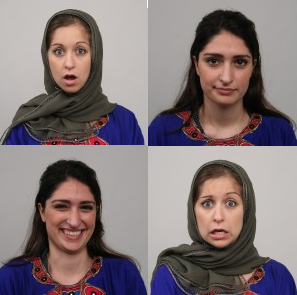The Tokyo Olympics are a month away! The Olympic Games are set to begin Friday July 23rd and are an excellent place to observe body language and nonverbal behavior; tensions are high and emotions are always on full display.
Keep in mind no matter how many times the Olympic venues and locations change, the facial expressions on an athlete’s face do not. The thrill of victory and the agony of defeat will always be signaled on the face in the same way.
What nonverbal displays can you observe at the Olympic Games? Read on to learn more…
1) Universal Facial Expressions of Emotion
The Olympics give us an opportunity to read people exhibiting unfiltered, raw emotions. With emotions as high as they are during the Games, few people would attempt to conceal their emotions, even if they weren’t so physically exhausted!
Humintell Director Dr. David Matsumoto’s experience as an Olympic Judo coach and International Judo Federation (IJF) Researcher has given him unique insight into the way Olympians express emotions.
His study entitled “Spontaneous facial expressions of emotion of congenitally and non-congenitally blind individuals” was published in the Journal of Personality and Social Psychology. The first of its kind, he studied congenitally blind (blind from birth) and sighted judo athletes at the 2004 Paralympic Games and the 2004 Summer Olympic Games in Athens, Greece.
During the course of the study, more than 4,800 photographs were captured and analyzed, including images of athletes from 23 countries. According to the findings, there were “no differences between congenitally blind, non-congenitally blind, and sighted athletes, either on the level of individual facial actions or in facial emotion configurations”.
This meant that the blind and sighted athletes produced the exact same facial expression, firing the exact same muscles at exactly the same time in similar situations.
These findings provide compelling evidence that facial expressions of emotion are hardwired into our genes and are not learned culturally.
2) Duchenne Smiles

After examining photos from top competitors in the 2004 Olympic Games, Dr. Matsumoto observed that the winners almost all sported pronounced, genuine smiles.
He referred to these as the Duchenne smile, and the genuine nature of the setting showcases these as truly prototypical expressions of happiness.
These involved: “smiles that involve not only the smiling muscle that pulls the lip corners up but also the muscle around the eyes, which lifts the cheeks, narrow the eyelids and produces crow’s feet wrinkles.”
3) Displays of Triumph

In addition to being an amazing showcase of emotions, the Olympics also demonstrate the unity of human emotions across cultures. Given that the Games bring athletes together from all over the world, they present a prime study in the differences and similarities between different expressions of emotions.
Dr. Matsumoto’s research has also found that, upon winning the gold, Olympic athletes almost invariably showcase the same emotion: triumph.
Interestingly, this is not traditionally included as a universal basic emotion, but all the same, Dr. Matsumoto found it again and again in pictures and videos of triumphant competitors. He noted: “When we studied pride, there was always something gnawing at me because some of the expressions that were previously labeled pride just didn’t make that much sense to me.”
 Eventually, he and fellow Humintell researcher Dr. Hyi Sung Hwang labeled this emotion triumph, contending that “Triumph has its own signature expression that is immediate, automatic and universal across cultures.” Instead of the subtle, self-satisfied smile that marks pride, triumph is displayed in a jubilant, almost aggressive fashion.
Eventually, he and fellow Humintell researcher Dr. Hyi Sung Hwang labeled this emotion triumph, contending that “Triumph has its own signature expression that is immediate, automatic and universal across cultures.” Instead of the subtle, self-satisfied smile that marks pride, triumph is displayed in a jubilant, almost aggressive fashion.
Interestingly, this emotion holds even in cultures where dominance and triumph are generally deemphasized in favor of humility, and it can be seen amongst non-human primates and even other animals as well. This all suggests a deep evolutionary and biological root behind the emotion of triumph, which we have also noted with other emotions.
Moreover, its manifestation is not just limited to a facial expression. Triumph is often accompanied by a sort of “victory stance,” with arms raised and head held up high. This holds for victors from all over the world, emphasizing past research that found similarities in gestures universally across cultures.
4) The Face Cover
We often see athletes and individuals in high stress, emotional situations do what Dr. Matsumoto calls a “face cover”.
But why exactly do people cover their face in emotional and stressful times?
Some individuals believe that the face cover is only a part of social communication, but Dr. Matsumoto believes that it is not. He believes that individuals often cover their face to conceal their emotions and that it is an immediate reaction that most people cannot control.
Dr. Matsumoto also suggests that covering one’s face could also have some evolutionary basis, rooted in not letting enemies see your emotions because it could potentially be a danger to your well-being. Nonetheless, this gesture is immediate and unconscious.
Keep your eye out for this behavior and you’ll surprisingly see it fairly frequently (you may even catch yourself doing it!)
The post 4 Body Language Displays You’ll See at the Tokyo Olympics first appeared on Humintell.

 Of all these signals, facial expressions of emotion are very, very special, because emotions are special types of psychological phenomena. As we’ve been discussing in our past few blogs, emotions are reactions to events that are meaningful for us.
Of all these signals, facial expressions of emotion are very, very special, because emotions are special types of psychological phenomena. As we’ve been discussing in our past few blogs, emotions are reactions to events that are meaningful for us.  Facial expressions are also special because they can signal different, discrete emotions (otherwise known as the
Facial expressions are also special because they can signal different, discrete emotions (otherwise known as the 
 Thus, reading each of the universal facial expressions of emotion is so important because when we read faces, we are actually reading the mind processing and evaluating stimuli. And when we see a specific, discrete emotion, we know how they evaluated something. We know the direction of what people are thinking, and equally important, we know what their bodies are primed to do doing before they do. Think about how important this is for people in harm’s way.
Thus, reading each of the universal facial expressions of emotion is so important because when we read faces, we are actually reading the mind processing and evaluating stimuli. And when we see a specific, discrete emotion, we know how they evaluated something. We know the direction of what people are thinking, and equally important, we know what their bodies are primed to do doing before they do. Think about how important this is for people in harm’s way. There are additional benefits to being interested in reading facial expressions of emotion, too. Doing so shows interest in others by paying attention.
There are additional benefits to being interested in reading facial expressions of emotion, too. Doing so shows interest in others by paying attention.